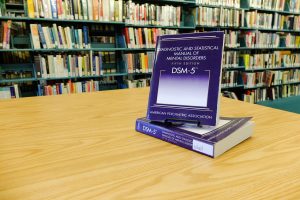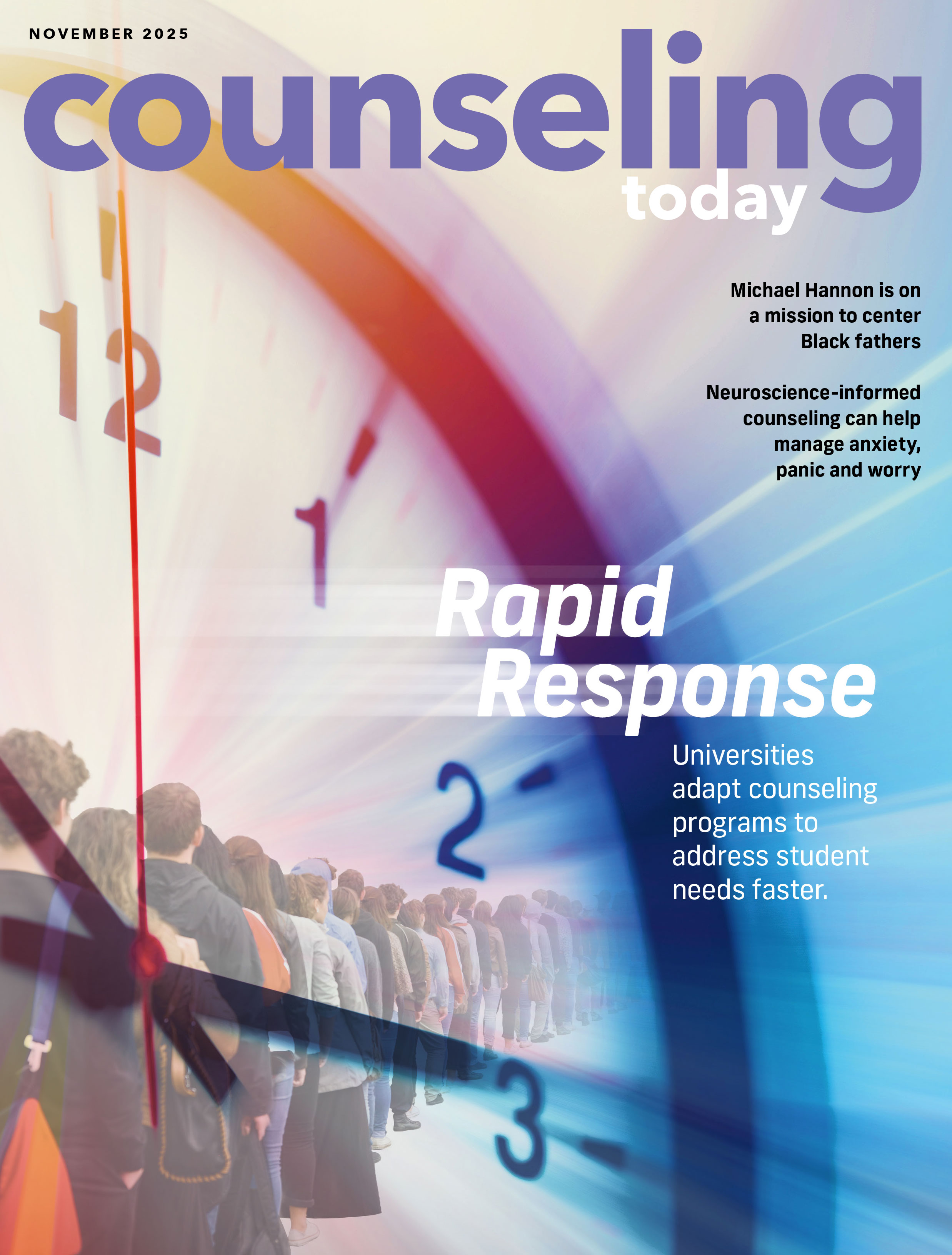What’s new with the DSM-5-TR?
By Aaron L. Norton
September 2022

Traditionally, our holistic emphasis on a wellness model as opposed to a medical model has been touted as a unique aspect of our professional identity as counselors. Many counselors feel more comfortable with humanistic, existentialist and postmodern theories that seem to clash with the medical model. The Diagnostic and Statistical Manual of Mental Disorders (DSM), published by the American Psychiatric Association (APA), is one of the most salient symbols of that model, so why should we care about it?
The ability to diagnose using a medical model is integral to much of what we want for our profession, such as Medicare parity, licensure portability, fair and equal access to psychological tests, and integrated care. For this reason, counseling associations have advocated relentlessly for state legislators to include the diagnosis of mental disorders in the scope of practice of licensed counselors.
According to the National Conference of State Legislature’s Scope of Practice Policy website, 36 states and U.S. territories specifically include diagnosis in behavioral health providers’ scope of practice, and an additional 19 states and U.S. territories neither empower nor prohibit counselors from diagnosis.
This diagnostic power conferred by the state comes with great responsibility, and the 2014 ACA Code of Ethics calls on counselors to diagnose properly (see Standard E.5.a.). The DSM is the most widely recognized diagnostic system for mental disorders. Although the DSM is imperfect and flawed, and there are alternative ways of conceptualizing mental health, it is nonetheless important for counselors to have a working knowledge of it.
In the following sections, I explore some common questions counselors have about the latest edition, the DSM-5-TR, which was published in May.
Why DSM-5-TR? Why not DSM-6?
The “TR” stands for “text revision.” Essentially, this means that APA intended to update the research components of the text and clarify some of the diagnostic criteria, but there were not enough advances in the field to support the need for the creation, revision and elimination of multiple disorders. The DSM-5 was published in 2013, and the research and statistical data contained in the manual are now outdated. The DSM-5-TR provides updated data consistent with research published since 2013.
How was DSM-5-TR developed? Were any counselors involved?
The DSM-5-TR revision started in the spring of 2019, and the final version was published in March. The DSM-5-TR specifically includes counselors in a list of professionals the text was written for, but were any counselors involved in the revision itself?
Over 200 multidisciplinary subject matter experts were involved in the revision — 64% psychiatrists, 30% psychologists and just 6% “other health professionals.” The text states that “many professional and educational groups were involved in this development and testing of DSM-5, including physicians, psychologists, social workers, nurses, counselors, epidemiologists, statisticians, neuroscientists, and neuropsychologists.” It is unclear how many counselors were involved in the revision, but it does not appear that many were.
Three primary groups were involved in the revision, including the DSM-5 Task Force, DSM Steering Committee and Revision Subcommittee. Experts were divided into 20 disorder review groups, each headed by a section editor. Four cross-cutting review groups (culture, sex and gender, suicide, and forensic) recommended updates throughout the text. Revisions were approved by the APA Board of Trustees, and public feedback was solicited and considered.
Are there any new disorders in DSM-5-TR?
There is only one new disorder in the DSM-5-TR: prolonged grief disorder. It is an updated version of a disorder that we saw in Section III of the DSM-5 (i.e., the section that describes conditions being considered for future editions of the DSM) called persistent complex bereavement disorder. It can now be found in Section II of the DSM-5-TR in the “Trauma and Stressor-Related Disorders” chapter because it is considered a reaction to a trauma or stressor.
The diagnosis of prolonged grief disorder is conceptualized as an intense longing or yearning, often with intense sorrow and emotional pain, for a deceased person close to the bereaved client, accompanied by preoccupation with thoughts or memories of the deceased person. It can only be applied if:
- the deceased person died more than 12 months ago (for adults) or 6 months ago (for children and adolescents);
- the client has a persistent grief response present on most days “to a clinically significant degree” (e.g., intense longing/yearning for the deceased, preoccupation with thoughts and memories of the deceased);
- at least three of eight specified symptoms (i.e., identity disruption, marked sense of disbelief about the death, avoidance of reminders about the death, intense emotional pain, difficulty reintegrating into relationships and activities, emotional numbness, feeling that life is meaningless, and intense loneliness) have been present most days to a clinically significant degree;
- symptoms cause clinically significant impairment or distress;
- duration and severity of bereavement clearly exceed social, cultural or religious norms; and
- the disturbance is not better explained by another disorder or the effects of one or more substances.
Its prevalence is unknown, but the DSM-5-TR references a rate of 9.8% with little clarity about that statistic (i.e., whether it is cross-sectional or a lifetime or perhaps 12-month prevalence rate).
Critics of the new disorder voice concerns that grief is being pathologized. Proponents, however, point out that only a small percentage of bereaved clients would meet the diagnostic criteria, the criteria clearly represent an unusual response to grief, individuals who meet criteria respond to specialized therapeutic approaches (i.e., prolonged grief disorder therapy) while their peers with uncomplicated bereavement require less intervention, and those individuals need professional help that might be difficult to access without the construct of a diagnosis.
What about racism, discrimination and cultural considerations? Anything new?
A cross-cutting review committee on cultural issues consisting of 19 U.S. and international-based experts in cultural psychiatry, psychology, and anthropology and an ethnoracial equity and inclusion work group of 10 mental health practitioners from diverse ethnic and racialized backgrounds with expertise in disparity-reduction practices were involved in the development of the DSM-5-TR. Because of their work, several semantic changes were made to the text, including the following:
- The terms “race” and “racial” were replaced by “racialized” to highlight the socially constructed nature of race.
- The term “ethnoracial” was used to denote U.S. Census Bureau categories Hispanic, white, or African American that combine ethnic and racialized identifiers.
- The terms “minority” and “non-white” were avoided, as these terms infer that white is hierarchical to other racial identities, thus perpetuating social hierarchies.
- The term “Latinx” replaced Latino/Latina in an effort to be sensitive to individuals who do not identify with binary gender markers. This revision may be lauded by transgender advocates but could also be frustrating to many Hispanic Americans who view the term Latinx as a form of colonialist intrusion into their language. Polling data from the Pew Research Center in December 2019 revealed that 76% of Hispanic adults had never heard of the term Latinx, 20% had heard it but didn’t use it, and only 3% used the term. According to an article published in Politico in December 2021, nearly half of Hispanic Americans view the term Latinx as offensive, so the two largest Spanish-speaking television networks in the country opted to replace Latinx with Latino and Latina. In an article published in The Conversation in September, Melissa Ochoa, an assistant professor of women’s and gender studies, reported that the governments of Argentina and Spain released public statements banning use of the term Latinx in July, and the term “Latine” has emerged as a more suitable gender-neutral term to replace the terms Latino and Latina because it does not violate rules of the Spanish language. It will be interesting to see whether Latinx or Latine becomes more widely accepted with time.
- The term “Caucasian” was replaced with “non-Latinx white.”
- Throughout the DSM-5-TR, prevalence data on specific ethnoracial groups has been included when possible.
What other disorder-related changes were made?
Some relatively minor changes (most of which are semantic) were made for a few other disorders. In my opinion, one of the most important changes involves the creation of diagnostic codes for suicidal behavior and nonsuicidal self-injury, which will allow for more effective tracking of these conditions. Other changes include the following:
- The DSM-5 contained two sets of codes next to each disorder: the International Classification of Diseases, Ninth Revision (ICD-9) and Tenth Revision (ICD-10) codes. Because all U.S. health care providers regulated by the Health Insurance Portability and Accountability Act were supposed to transition to ICD-10 codes on Oct. 1, 2015, the ICD-9 codes have all been removed from the text.
- The Criterion A phrase “as manifested by the following” for autism spectrum disorder was replaced with “as manifested by all of the following” to maintain high diagnostic threshold.
- Disruptive mood dysregulation disorder was clarified as diagnosable between ages 6 and 18.
- The note “witnessing does not include events that are witnessed only in electronic media, television, movies, or pictures” in Criterion A2 of posttraumatic stress disorder was removed for children 6 years and younger due to redundancy.
- The phrase “with relatively intact reality testing” was removed from attenuated psychosis syndrome, and symptoms were described more accurately.
- A new set of severity descriptors was added to bipolar disorder.
- The phrase “reduced orientation to the environment” for delirium was replaced with “accompanied by reduced awareness of the environment.”
- Conversion disorder was renamed as functional neurological symptom disorder.
- Several terms related to gender dysphoria were altered. Specifically, “desired gender” was replaced with “experienced gender,” “cross-sex medical procedure” was replaced with “gender affirming medical procedure,” “cross-sex hormone treatment” was replaced with “gender affirming hormone treatment,” “natal male” was replaced with “individual assigned male at birth,” “natal female” was replaced with “individual assigned female at birth,” and “differences in sex development” was noted as an alternative term for “disorders of sex development.”
- For intellectual disorder, renamed intellectual developmental disorder, clarification was provided that although one should not be bound narrowly to the 65-75 IQ score range, the diagnosis would not be appropriate for those with substantially higher IQ scores.
- For major depressive disorder, the Criterion D phrasing “The occurrence of the major depressive episode is not better explained by schizoaffective disorder” was changed to “At least one major depressive episode is not better explained by schizoaffective disorder and is not superimposed on schizophrenia.”
- Narcolepsy subtypes were revised to harmonize with the third edition of the International Classification of Sleep Disorders and ICD-11.
- Olfactory reference disorder (olfactory reference syndrome), which the DSM-5 referred to as “Jikoshu-kyofu,” replaced other specified obsessive-compulsive and related disorder to dispel the misunderstanding that the disorder only occurs in Japan.
- In the third example of other specified bipolar and related disorder, the line “if this occurs in an individual with an established diagnosis of persistent depressive disorder (dysthymia), both diagnoses can be concurrently applied during the periods when the full criteria for a hypomanic episode are met” was deleted because of a conflict with Criterion E for persistent depressive disorder, which states in part that “there has never been a manic episode or a hypomanic episode.”
- Manic episode superimposed on a psychotic disorder was added as the fifth example of other specified bipolar and related disorder with the intention of being used when other psychotic disorders from the exclusion criterion for Bipolar I and Bipolar II disorders (i.e., schizophrenia, delusional disorder, psychotic disorder not otherwise specified) do not have mood episodes as part of their diagnostic criteria, leaving no way for the mood episodes to be accounted for by the diagnosis.
- The DSM-5 example of “attenuated delirium syndrome” under other specified delirium was replaced with “subsyndromal delirium.”
- “Major depressive episode superimposed” was added as a fourth example of other specified depressive disorder for use when a major depressive episode occurs concurrent with a psychotic disorder that does not have mood episodes as part of its diagnostic criteria.
- The sentence “individuals with atypical anorexia nervosa may experience many of the physiological complications associated with anorexia nervosa” was added to the description of the atypical anorexia nervosa example of other specified feeding or eating disorder to clarify that the presence of physiological consequences during presentation does not mean that the diagnosis is the (typical) anorexia nervosa.
- In the fourth example of other specified schizophrenia spectrum and other psychotic disorder, the phrase “delusional symptoms in partner of individual with delusional disorder” was changed to “delusional symptoms in the context of relationship with an individual with prominent delusions” to clarify that (a) the “inducer” does not need to have a romantic relationship with the patient and (b) the “inducer” does not necessarily need to have a delusional disorder.
- For persistent depressive disorder, the parenthetical “dysthymia” was removed to avoid confusion with DSM-IV-TR diagnosis of dysthymic disorder, which could not be diagnosed if the individual had ever met criteria for a major depressive disorder. Additionally, all specifiers were removed except anxious distress and atypical features.
- The parenthetical “social phobia” in social anxiety disorder was removed.
- For substance/medication-induced bipolar and related disorder, the DSM-5 Criterion A terminology “prominent and persistent disturbance in mood that predominates in the clinical picture and is characterized by elevated, expansive, or irritable mood, with or without depressed mood” was changed to “prominent and persistent disturbance in mood that predominates in the clinical picture and is characterized by abnormally elevated, expansive, or irritable mood and abnormally increased activity or energy.” Additionally, the DSM-5 Criterion B1 phrase “developed during or soon after substance intoxication or withdrawal or after exposure to a medication” was changed to “developed during or soon after substance intoxication or withdrawal or after exposure to or withdrawal from a medication.”
What changes were made to Section III in DSM-5-TR?
Section III of the DSM-5-TR contains emerging measures and models relevant to the diagnosis and conceptualization of mental disorders. Specifically, it contains several free assessment measures that counselors can use in clinical practice, additional information on cultural considerations for diagnosis, an alternative model for personality disorders, and conditions that are being considered for adoption in future revisions of the DSM. Changes made to Section III include the following:
- Male and female checkboxes were removed from all assessment measures in a shift away from binary gender identification.
- Instructions in the Clinician-Rated Dimensions of Psychosis Symptom Severity measure were edited to mirror new severity specifiers for psychotic disorders added to Section II.
- Scoring instructions for the World Health Organization Disability Assessment Schedule 2.0 were clarified.
- Terms such as “culture,” “race” and “ethnicity” were revised in the Cultural Formulation Interview.
If I already own the DSM-5, do I need to purchase the DSM-5-TR?
Given that the DSM-5-TR contains a new diagnosis and updated research, I recommend obtaining a new copy. However, if you are not concerned with prolonged grief disorder and you do not use the statistical information in the DSM, then you may not have a sense of urgency to purchase the new edition.
Where can I go to learn more?
Here are some resources where you can learn more about the DSM-5-TR:
- APA’s DSM-5-TR Fact Sheets provides more detailed information about the changes in this new edition.
- APA’s DSM-5-TR Online Assessment Measures contains free assessment measures designed to help counselors screen and assess for many DSM-5-TR
- I have several related videos related to the DSM available on my YouTube channel, including how to use free online assessment measures, how to use DSM-5 tools for differential diagnosis and how to diagnose Z codes from the DSM.
**** Aaron L. Norton
is the executive director of the National Board of Forensic Evaluators,
a visiting instructor at the University of South Florida’s Department
of Mental Health Law & Policy, and the southern regional director
for the American Mental Health Counselors Association.
Aaron L. Norton
is the executive director of the National Board of Forensic Evaluators,
a visiting instructor at the University of South Florida’s Department
of Mental Health Law & Policy, and the southern regional director
for the American Mental Health Counselors Association.
The views expressed in Counseling Today are those of the authors and contributors and may not reflect the official policies or positions of the editors or the American Counseling Association.


